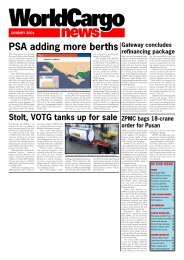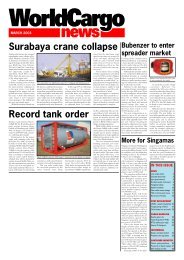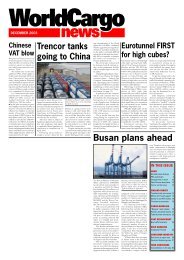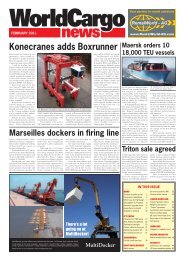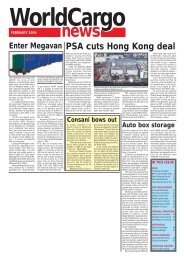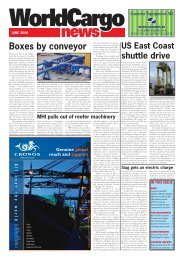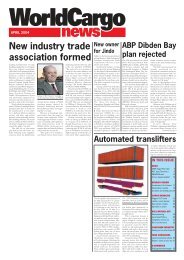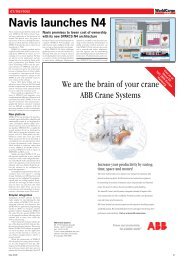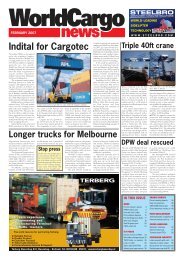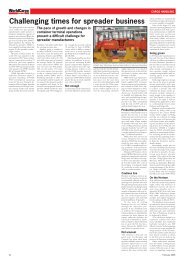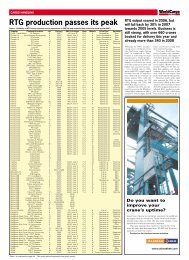Tanjung Priok super port - WorldCargo News Online
Tanjung Priok super port - WorldCargo News Online
Tanjung Priok super port - WorldCargo News Online
Create successful ePaper yourself
Turn your PDF publications into a flip-book with our unique Google optimized e-Paper software.
CARGO HANDLING<br />
Could <strong>port</strong>s get cross about tyres again<br />
In recent years tyres used in heavy mobile<br />
plant applications in <strong>port</strong>s have increasingly<br />
moved away from bias ply (or<br />
cross ply) to radial construction, even<br />
though radials covers are more expensive.<br />
Although several factors are involved<br />
in the switch, from an operator’s perspective<br />
the main one is that radial tyres have<br />
lower rolling resistance and run cooler so<br />
they save on fuel costs and are less prone<br />
to overheating and hence last longer. This<br />
translates into lower costs per running<br />
hour, - the main criterion.<br />
Despite sidewall reinforcements,<br />
radials still lag behind bias tyres in puncture<br />
resistance, but provided the terminal<br />
surface is reasonably clean, this should not<br />
be too much of a drawback. On the other<br />
hand, notwithstanding various improvements<br />
over the years, radial tyres still inherently<br />
flexes more than the equivalent<br />
bias tyre and this can cause stability problems<br />
at high stacking heights.<br />
To overcome this problem, equipment<br />
operators often inflate the front (or forward<br />
travel) tyres above the 10 bar norm.<br />
This increases tyre “stiffness,” but it also<br />
reduces the tyre contact area, which in<br />
turn causes accelerated wear, thus negating<br />
the reason for fitting radial covers in<br />
the first place.<br />
New departure<br />
After several years of R & D in Germany<br />
and extensive factory testing and operator<br />
trials, Continental Tyres Group has<br />
chosen TOC CSC Europe in Rotterdam<br />
in June to launch a brand new range of<br />
<strong>port</strong> tyres. TOC CSC attendees will be<br />
invited to witness the new tyres in use<br />
on heavy equipment with a Rotterdam<br />
terminal operator.<br />
No details of the tyres have been released<br />
prior to launch, but it is known<br />
that the key innovation is that these are<br />
bias tyres, therefore with inherent excellent<br />
stability characteristics, but a completely<br />
new tread pattern delivers cooler<br />
running and hence a tyre life that is<br />
claimed to get closer to that of a radial<br />
tyre. If you then factor in the lower price<br />
for bias construction, the claimed result<br />
is an even lower cost per running hour<br />
than is possible with the best radial covers.<br />
Braking distance is also said to be<br />
shorter in a like-for-like comparison.<br />
Continental has tested the new tyres<br />
in different countries on various machines<br />
and in widely varying climatic conditions,<br />
and is confident that it is “onto a winner.”<br />
As part of the launch, all the new<br />
<strong>port</strong> tyres will be branded to Continental<br />
and the Simex brand will no longer<br />
be used for <strong>port</strong> tyres.<br />
Enhancements<br />
Continental has also announced a number<br />
of product enhancements to various smaller<br />
industrial tyres. For example, the tread<br />
depth of the RT20 radial tyre for FLTs has<br />
been increased to the point where 30%<br />
greater service life can be achieved, the<br />
company claims. Laden travel speeds of up<br />
to 25 mph are possible, and a high-traction<br />
tread pattern enables the FLTs to carry<br />
heavy loads on unsurfaced ground as well<br />
as paved ground.<br />
The CSEasy resilient tyre is fitted with<br />
an adapter between the tyre and the rim.<br />
This allows the tyre to be fitted directly<br />
onto any Lemmerz-contoured rim simply<br />
by using a torque wrench. There is no<br />
need for a mounting press, so the time<br />
A major product launch at TOC CSC<br />
Europe could change the thinking about<br />
tyres on mobile container handling plant<br />
taken to change a tyre is drastically reduced.<br />
This means, for example, that FLT<br />
retailers and hire companies can easily<br />
change between standard and non-marking<br />
tyres depending on the customer’s<br />
requirements.<br />
Continental was the first company to<br />
develop a resilient tyre capable of being<br />
mounted on a pneumatic tyre rim and<br />
says that its range of <strong>super</strong>elastic tyres now<br />
account for 40% of the world’s industrial<br />
tyre market. To date over 8M <strong>super</strong>elastic<br />
tyres have been produced.<br />
Retreads<br />
The company has also introduced<br />
LifeCycle, a retreaded <strong>super</strong>elastic tyre.<br />
The worn tread is removed from the cas-<br />
Radial tyres, such as these Nokian BAS tyres,<br />
dominate the straddle carrier market. Could<br />
Continental change all that<br />
Tackling the toughest tasks<br />
<strong>WorldCargo</strong><br />
news<br />
Katoen Natie in the Port of Antwerp is a recent<br />
customer for Continental SC20 CSEasy<br />
<strong>super</strong>elastic tyres. The tyres are fitted all-round<br />
to its fleet of indoor- and outdoor-working<br />
warehouse FLTs<br />
VCHR delivers exceptionally long tire life and <strong>super</strong>ior driving comfort leading to cost effectiveness and<br />
operational safety. With their outstanding performance in the toughest conditions, VCHR tires can successfully<br />
tackle diverse tasks throughout your site to keep your operations in reliably on target.<br />
Tire size Load index/speed symbol TRA code<br />
16.00R25 200A5 Industrial Service<br />
VCHR<br />
V-steel Container Handler Rib<br />
For your nearest Bridgestone Authorized Dealer,<br />
visit our web site<br />
www.bridgestone.com<br />
May 2013 79



